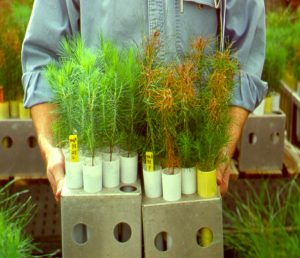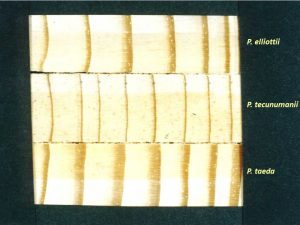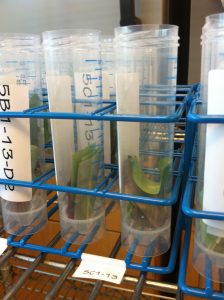Species Characterization
Camcore’s primary objectives are Gene Conservation and Tree Improvement, but another critical objective can be summarized as Species Characterization. Many of the species we work with have not been widely studied or utilized, so for these we need to learn almost everything. For example, we study reproductive biology, vegetative propagation, seed handling, nursery management, silvicultural requirements, disease resistance, frost and drought tolerance, and wood properties. The more that we know about a species, the better we will be able to to conserve the species and/or to develop commercial plantation programs. Some examples of the types of projects we do are listed below:
Disease Screening

We screen species of pines and eucalypts for resistance to forest tree diseases that have significant impact on plantation forestry programs. For pines, one of these diseases is pitch canker, caused by Fusarium circinatum, that causes mortality in important commercial species like P. radiata and P. patula. Our screening programs have identifed a number of species, such as P. tecunumanii, P. oocarpa, and P. maximinoi, that are highly resistant to this pathogen.
Around the world, there are many diseases that attack eucalypts. Recently, we have initiated a disease screening effort to test a number of subtropical and temperate eucalypt species for resistance to three diseases of concern to members: Puccina psidii, Botryosphaeria, and Teratosphaeria (Coniothyrium Canker). The project is a collaboration between Camcore, Smurfit Kappa Colombia (SKC), and Weyerhaeuser andINIA in Uruguay, and the initial phase will test Camcore breeding material of E. urophylla, E. pellita, E. brassiana, E. camaldulensis, E. grandis, E. dunnii, E. longirostrata, E. benthamii, E. dorrigoensis, E.badjensis, E. globulus, and E. nitens against the pathogens.
Wood Properties

Wood properties are of critical importance to our members, as they affect the final product quality of the paper, sawtimber, and other solid wood products. We assess wood density, wood chemistry, and wood strength properties of our pine and eucalpyt species and provenances. For example, we have learned that many of our subtropical pine species (e.g., P. maximinoi, P. tecunumanii, and P. oocarpa) have quite different wood properties than temperate species such as P. taeda and P. radiata. The subtropical species have more uniform density, higher cellulose, lower lignin, and stronger timber strength than the temperate species. Among eucalypts, we have found large and important differences among E. urophylla provenances for density and wood chemistry. We are now studying the genetic control of these traits in commercial populations of E. dunnii and E. grandis.

Frost Tolerance
Another factor of critical importance for plantation forestry is frost tolerance. Typically, we are interested in very fast-growing species, but often these specie have very little frost tolerance, limiting the regions where they can be planted. We have done laboratory screening for frost tolerance in the laboratory, assessing tolerance with electrolyte conductivity. For both pines and eucalypts, these techniques have utility to rank species, provenances, and families for frost tolerance.

